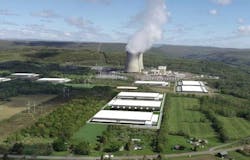Nuclear-powered data centers? The idea may not be as far-fetched as was long thought. The global effort to slow climate change is making progress, but still trails the benchmarks that scientists say are needed to forestall dramatic changes in weather and environment. Data centers have been leading players in the adoption of renewable energy sources like wind and solar power. But as the scale of digital infrastructure continues to increase, a growing number of industry thought leaders are contemplating a role for nuclear power.
So we put the question to the DCF Executive Roundtable. Are nuclear-powered data centers an option?
Our panelists include Sean Farney of Kohler Power Systems, Michael Goh from Iron Mountain Data Centers, DartPoints’ Brad Alexander, Amber Caramella of Netrality Data Centers and Infrastructure Masons, and Peter Panfil of Vertiv. The conversation is moderated by Rich Miller, the founder and editor of Data Center Frontier. Here’s today’s discussion:
Data Center Frontier: Several data center observers, including The Uptime Institute, have highlighted nuclear power as an option for data center operators to create a low-carbon energy future. Is turning to nuclear power – either through power purchase agreements or modular reactors – a viable option for the data center industry? Should it be?
SEAN FARNEY, Kohler Power Systems
Sean Farney, Kohler Power Systems: Absolutely! I ran a 120MW data center in Illinois (the US state that produces the most nuclear energy) and had unsurpassed reliability and rock-bottom costs. Look at what Cumulus Data is doing today. Carbon-free power at $.03/kWh – it’s unbeatably green, massively scalable, and ultimately reliable. The problem? Marketing. Nuclear is perceived as dangerous and dirty when it’s one of the safest and cleanest forms of energy.
If the data center industry can defeat this perception, there’s potential for massive sustainability advances. China and France have solved for the perception issue and are benefitting from self-reliance, particularly in an unstable global energy market. To take this idea a little further, I only half-jokingly believe that private nuclear is not far off. If grid instability continues and ESG-pressure grows, the hyperscalers – who have the necessary brainpower, deep pockets, and financial incentives – could push private nuclear forward.
Data centers already hire all the ex-Navy nukes, so there’s not a massive skills gap. A microgrid design with private nuclear as primary and the utility grid as secondary power would be groundbreaking.
BRAD ALEXANDER,
DartPoints
Brad Alexander, DartPoints: I feel strongly that nuclear power could be an alternative power option for many dense data center markets. Power purchase agreements for densely populated data center areas could be a very attractive option that would provide ongoing sustainable nuclear power to many providers in metro regions.
Small Modular Reactors (SMRs) are still a long way out, in my opinion. In the next 30 years, however, I can envision SMRs gaining traction – again in dense areas – where a single data center provider could power its entire metro campus by deploying and maintaining its own plant.
MICHAEL GOH,
Iron Mountain
Michael Goh, Iron Mountain Data Centers: We recognize nuclear as being carbon free generation when we calculate our 24/7 carbon free energy consumption. This is consistent with how Google recognizes nuclear generation on the grid.
That said, we are not likely to pursue contracts with new nuclear generation projects like we would with wind or solar. In fact, many nuclear projects are being decommissioned and there are legitimate concerns over the future safety and environmental impact of spent fuel.
Nuclear technology may change over time and address the concerns that exist today. Until then, the lowest cost sources of carbon free energy remain wind, solar and geothermal.
AMBER CARAMELLA,
Infrastructure Masons and Netrality
Amber Caramella, Infrastructure Masons and Netrality: Nuclear power is a viable option for creating a low-carbon energy future. However, it has pros and cons. When thinking about nuclear power, there are benefits and drawbacks. For example, uranium is technically non-renewable, has high upfront costs, and produces nuclear waste. That said, there are some benefits in that it is carbon-free electricity, has a small land footprint, high power output, produces low-cost energy, and releases zero carbon emissions.
Yes, I view power purchase agreements (PPAs) for renewable electricity and modular reactors as sustainable options when turning to nuclear power because these long-term renewable energy contracts focused on decarbonizing electricity consumption, and modular reactors reduce economic, security, technical, and regulatory barriers for the next generation of nuclear power. Both are a solid start in decreasing our carbon footprint nationally and globally.
The clean energy revolution is expanding into renewable energy sources, including solar, wind, hydropower, and geothermal power. It has and will continue to transform how the world produces energy and what effects it will have on our environment. I am seeing more companies commit to implementing decarbonization strategies to reduce carbon footprint which is promising but believe we need to have more meaningful industry collaboration to drive the right behaviors in the market.
PETER PANFIL, Vertiv
Peter Panfil, Vertiv: We are seeing a sense of urgency around moving away from fossil fuels and enhancing data center resource utilization among many operators. We expect most to turn to renewable energy rather than nuclear power to achieve their sustainability goals. When paired with fuel cells for energy storage, the traditional UPS is morphing into an Intelligent power converter that allows the grid to provide emergency backup power.
Locally generated renewable energy presents the clearest and most cost-effective path toward a sustainable and climate-friendly future for the industry. The technologies required to support this goal are already further along than many realize, and are advancing rapidly.
NEXT: A recap of all the themes and insights from our Data Center Executive Roundtable for the First Quarter.
Keep pace with the fact-moving world of data centers and cloud computing by following us on Twitter and Facebook, connecting with DCF on LinkedIn, and signing up for our weekly newspaper using the form below:
About the Author


